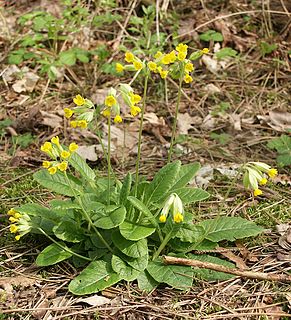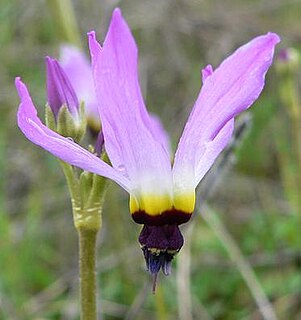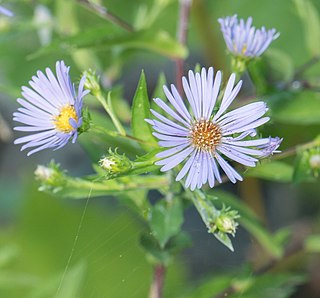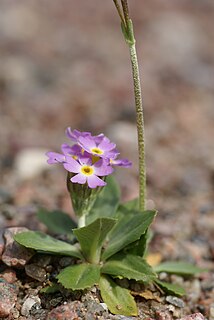
Fundy National Park is a national park of Canada located on the Bay of Fundy, near the village of Alma, New Brunswick. It was officially opened on 29 July 1950. The Park showcases a rugged coastline which rises up to the Canadian Highlands, the highest tides in the world and more than 25 waterfalls. The Park covers an area of 207 km2 (80 sq mi) along Goose Bay, the northwestern branch of the Bay of Fundy. When one looks across the Bay, one can see the northern Nova Scotia coast.

Primula is a genus of mainly herbaceous flowering plants in the family Primulaceae. They include the familiar wildflower of banks and verges, the primrose. Other common species are P. auricula (auricula), P. veris (cowslip), and P. elatior (oxlip). These species and many others are valued for their ornamental flowers. They have been extensively cultivated and hybridised. Primula are native to the temperate Northern Hemisphere, south into tropical mountains in Ethiopia, Indonesia, and New Guinea, and in temperate southern South America. Almost half of the known species are from the Himalayas.

Prunus virginiana, commonly called bitter-berry, chokecherry, Virginia bird cherry, and western chokecherry, is a species of bird cherry native to North America.

Primula veris, the cowslip, common cowslip, or cowslip primrose, is a herbaceous perennial flowering plant in the primrose family Primulaceae. The species is native throughout most of temperate Europe and western Asia, and although absent from more northerly areas including much of northwest Scotland, it reappears in northernmost Sutherland and Orkney and in Scandinavia. This species frequently hybridizes with other Primulas such as the common primrose Primula vulgaris to form false oxlip which is often confused with true oxlip, a much rarer plant.

Primula sect. Dodecatheon is a section of herbaceous flowering plants in the family Primulaceae. Primula species in this section were formerly considered in a separate genus, Dodecatheon. The species have basal clumps of leaves and nodding flowers that are produced at the top of tall stems rising from where the leaves join the crown. The genus is largely confined to North America and part of northeastern Siberia. Common names include shooting star, American cowslip, mosquito bills, mad violets, and sailor caps. A few species are grown in gardens for their showy and unique flower display.

Taughannock Falls State Park is a 750-acre (3.0 km2) state park located in the town of Ulysses in Tompkins County, New York in the United States. The park is northwest of Ithaca near Trumansburg.

Primula vulgaris, the common primrose, is a species of flowering plant in the family Primulaceae, native to western and southern Europe, northwest Africa, and parts of southwest Asia. The common name is primrose, or occasionally common primrose or English primrose to distinguish it from other Primula species also called primroses. None of these are closely related to the evening primroses.

The Slate Islands are a small archipelago in Lake Superior, Ontario, Canada, about 12 kilometres (7.5 mi) south of the town of Terrace Bay. The island group, consisting of 15 islands in total, was created by a meteorite impact which formed a crater about 32 km (20 mi) wide. In 1985, the Ontario government established the Slate Islands as a natural environment provincial park. The islands are notable for having Ontario's largest herd of boreal woodland caribou.

Primula clevelandii, with the common name of Padre's shooting star, is a species of primrose.

Symphyotrichum puniceum, is a species of flowering plant in the family Asteraceae native to eastern North America. It is commonly known as purplestem aster, red-stalk aster, red-stemmed aster, red-stem aster, and swamp aster. It also has been called early purple aster, cocash, swanweed, and meadow scabish.

Primula meadia, the shooting star or eastern shooting star, is a species of flowering plant in the primrose family Primulaceae. It is native to the eastern United States and Canada, spanning north from Manitoba and New York, south to Texas and Florida.

Dodecatheon conjugens, now reclassified as Primula conjugens, is a species of flowering perennial plant in the primrose family, known by the common name Bonneville shooting star.
Pig Hill is a Site of Special Scientific Interest in the County Durham district of north-east County Durham, England, situated 1 km south of the village of Easington Lane.

Primula cusickiana is a species of flowering plant in the primrose family known by the common name Cusick's primrose. It is native to the western United States in and around the Great Basin. Its distribution extends into Oregon, Idaho, Nevada, and Utah.

Dodecatheon austrofrigidum is a species of flowering plant in the primrose family known by the common names frigid shooting star and tundra shooting star. It is native to Washington and Oregon in the United States, where it grows in the coastal mountain ranges, including those on the Olympic Peninsula.
Primula rusbyi is a species of Primula. A common name is Rusby's primrose.

Cow Myers is a Site of Special Scientific Interest (SSSI) located in the Nidderdale Area of Outstanding Natural Beauty (AONB), near Ripon, North Yorkshire, England. The site was designated in 1984 for its fen and alder carr habitat, which supports a diversity of wetland plant life. Of particular interest are the bird's eye primrose which is scarce in Yorkshire, and early marsh orchid. There is no public access to this site, no vehicular access, and no public facilities.

Talsi rolling hills is a nature park in the middle of Talsi Municipality. It is located in the north-western part of Vanemas pauguraine and includes the highest part, administratively belongs to Laidzes, Laucienes and Lībagu parishes. The protected area was established in 1987 to protect one of the North Kurzeme Uplands and highest part of the Elder Hill. It is most diverse areas in terms of natural conditions in the Latvia north-east, with a distinctly hilly terrain and several small but deep lakes. Scenic area. Natura 2000 territory. Many Latvia rare and protected plant and animal species. In total 24 species of flora (1) and fauna (23) are protected under EU Nature directives.

Symphyotrichum yukonense is a species of flowering plant in the family Asteraceae endemic to disjunct areas in Alaska and the Canadian territories of Yukon and Northwest Territories. Commonly known as Yukon aster, it is a perennial, herbaceous plant 5 to 30 centimetres tall. Its flowers have purple to blue ray florets and yellow to brown disk florets. S. yukonense grows at elevations of 300–1,500 metres in mud flats and on sandy or silty lake shores. It is a NatureServe Vulnerable (G3) species and is classified Imperiled (S2) in its Canadian range.

Primula stricta, also known as the strict primrose, is a species of flowering plant in the family Primulaceae.

















